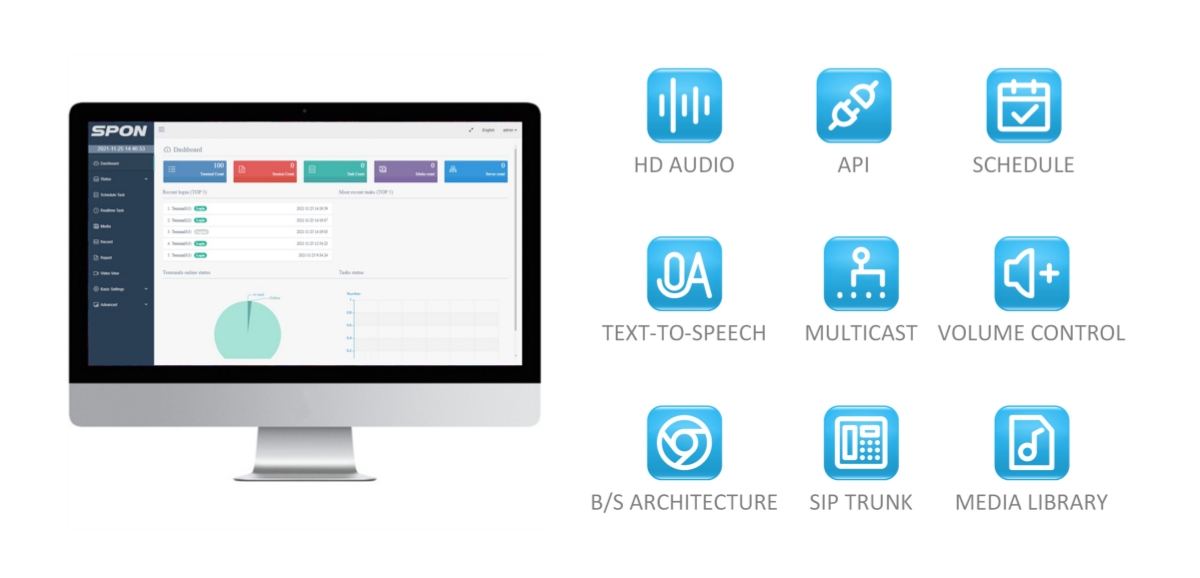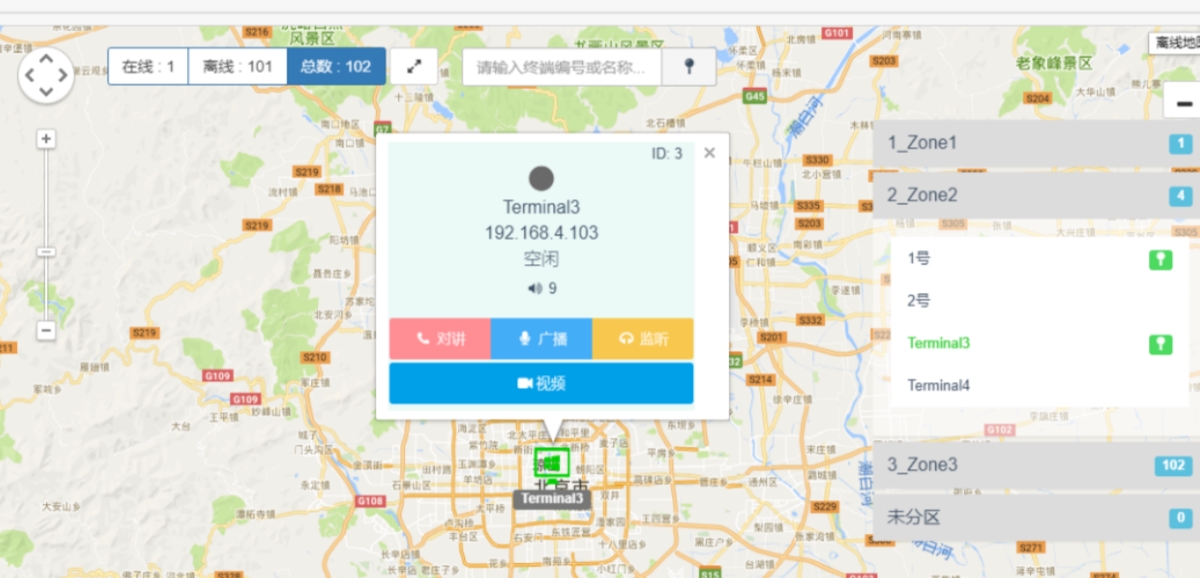In the landscape of modern communication systems, the IP PA (Public Address) Intercom System by SPON stands out as a powerful tool designed to meet the complex demands of various institutions. This all-IP solution is not just a public address system; it's a comprehensive communication platform that adapts to diverse applications, ensuring rapid, reliable, and secure information dissemination across local area networks (LANs) and the Internet.
The IP PA System by SPON is a state-of-the-art communication solution that extends beyond basic broadcasting needs. It incorporates features such as video monitoring, internal intercom, background music, and emergency broadcasting, optimizing resource utilization and centralized device management.
Key Features and Capabilities
Background Music: The system supports a variety of music sources, including AM/FM tuners, CD/DVD/MP3 players, computers, USB drives, and networked broadcasting hosts, allowing for the delivery of ambient music to various zones.
Daily Broadcasting: The IP PA System facilitates IP paging microphone broadcasts from the control room and automated system broadcasts. It offers rich features for personalized business broadcasts, including anytime paging, multi-source playback, offline broadcasting, TTS (Text-to-Speech) voice broadcasting, scheduled program playback, audio production tools, and permission management.
Emergency Broadcasting: With an independent emergency microphone input, the system acts as a backup in case of broadcast failures. It prioritizes emergency broadcasts, delivering pre-recorded fire evacuation broadcasts or urgent announcements.
Text-to-Speech Broadcasting: The system integrates TTS voice synthesis technology, addressing the challenges of large-scale broadcasting scenarios. It allows for convenient and high-quality business broadcasts, with the ability to save settings as templates for easy retrieval.
Audio-Text Synchronized Broadcasting: A pioneering feature that displays spoken content in textual form on LED screens or speakers, providing an audio-visual combination that enhances the reception of broadcast information.
Integrated Surveillance Broadcasting: The system integrates surveillance video, allowing for the display of external surveillance videos and the initiation of broadcasts within the current image window, achieving an organic combination of audio and video.
Visualized Management: The IP PA Intercom system features a visualized software management platform with a comprehensive "one-map" display interface, providing an overview of the entire system.
Two-Way Intercom and One-Touch Assistance: The system seamlessly integrates professional intercom technology, enabling two-way communication and real-time calls to the security center in emergencies.
Rich Interfaces: The system supports data communication with external devices and provides a secondary development SDK for integration with the user's comprehensive management platform.
Applications of the IP PA System
Educational Institutions: For routine communication, emergency broadcasts, and special education support.
Corporate Environments: Enhancing internal communication, background music delivery, and emergency response.
Public Facilities: Utilizing the system for public announcements, information dissemination, and integrated surveillance.
SPON's IP PA Intercom System is a powerful ally in the realm of communication technology. Its robust platform capabilities, all-IP design, and innovative features make it an ideal choice for institutions seeking to streamline their communication infrastructure. The system's ability to integrate with existing networks and other systems, coupled with its high-quality audio and versatile application, makes it an indispensable component of any advanced communication strategy.
By adopting SPON's IP PA System, organizations can ensure effective, efficient, and reliable communication, enhancing the overall experience for both staff and the audience. The IP PA System is not just a technological advancement; it's a strategic investment in the future of communication infrastructure.
With robust platform capabilities, SPON’s IP PA Intercom System adapts to diverse applications. The all-IP design allows easy network integration for a potent digital public address system, ensuring rapid, reliable, and secure information dissemination across LANs and the Internet.

The IP PA System extends beyond basic broadcasting, incorporating features such as video monitoring and internal intercom. This integration optimizes resource utilization and centralized device management.
1.Background Music
Source options include AM/FM tuners, CD/DVD/MP3 players, computers, USB drives, and networked broadcasting hosts, delivering ambient music to various zones.
2.Daily Broadcasting
IP paging microphone broadcasts from the control room and automated system broadcasts. The IP PA Intercom system offers rich features for personalized business broadcasts.
Anytime paging: Voice broadcasts to specific areas or groups via paging microphones.
Multi-source playback: Independent control of content on each terminal or broadcast by region or group.
Offline broadcasting: Terminals automatically download scheduled broadcasts during network idle times, ensuring uninterrupted playback even if disconnected.
TTS Voice Broadcasting: Text-to-speech function for automatic conversion and standard voice playback.
Scheduled program playback: Automated 24/7 broadcasting according to uploaded audio files and schedules.
Audio production: Free tools for recording, converting, and editing audio materials.
Permission management: Configurable user accounts with different privileges.
Real-time acquisition and broadcasting: Compression of external audio sources into high-quality data streams for real-time playback on front-end terminals.
3.Emergency Broadcasting
Independent emergency microphone input, control, and execution. Acts as a backup in automatic, semi-automatic, or manual broadcast failures. Prioritizes over other functions during emergencies, delivering pre-recorded fire evacuation broadcasts or urgent announcements.
The system's main control device features a prominent red emergency button for one-touch area-wide broadcasting, providing fire evacuation broadcasts or manual evacuation calls. Whether for routine fire drills or unforeseen emergencies, this system ensures swift response. It can be programmed for area-wide or adjacent zone alarm broadcasts, offering flexible usage.
4.Text-to-Speech Broadcasting
In large-scale broadcasting scenarios with diverse business requirements, traditional manual broadcasting or program recording methods lag behind. Selecting high-quality announcers is challenging, and ensuring consistent quality with each playback is difficult. The Text-to-Speech (TTS) digital voice synthesis system, powered by computer technology, addresses this issue. Users can input text into the computer, enabling convenient and high-quality business broadcasts. Moreover, it seamlessly facilitates multilingual conversion, offering flexibility, convenience, and efficiency.
The IP PA Intercom system integrates TTS voice synthesis technology for text-to-speech broadcasts. The user-friendly interface allows intuitive configuration of broadcast voice type, speed, background music, and volume. Settings can be saved as templates for easy retrieval.
TTS voice synthesis is applicable for scheduled broadcasts, real-time broadcasts, and triggered broadcasts, assisting users in efficiently completing various broadcasting tasks. It standardizes the broadcasting effect, mitigating variations in voice quality across different individuals.
5.Audio-Text Synchronized Broadcasting
In venues like auditoriums, theaters, and concert halls, LED screens are often used to display lyrics for audience convenience. Movie or TV show broadcasts without subtitles may cause viewers to miss out on some exciting dialogues. The IP PA intercom system pioneers the introduction of subtitles into public broadcasting, presenting a novel concept of Audio-Text Synchronized Broadcasting. This approach simultaneously displays spoken content in textual form on LED speakers or screens, achieving synchronized audio and text. Through this audio-visual combination, audiences can better and more comprehensively receive broadcast information. Particularly beneficial in special education schools, Audio-Text Synchronized Broadcasting aids hearing-impaired students, enabling them to "hear" broadcasts.
6.Integrated Surveillance Broadcasting
The IP PA intercom system integrates surveillance video, allowing the system client to display external surveillance videos in split screens and initiate broadcasts within the current image window. Through the linkage configuration between cameras and broadcasting, it achieves the organic combination of audio and video. Real-time monitoring of the on-site situation enables direct communication with specific broadcast areas when anomalies are detected, enhancing management capabilities. The system supports adding IPC surveillance points, binding broadcasting to N-to-N modes, enabling one surveillance point to link with multiple speakers and multiple surveillance points to link with a specific speaker.

7.Visualized Management
The IP PA Intercom system features a visualized software management platform with a comprehensive "one-map" display interface. This interface provides an overview of the entire system, including terminal quantity, terminal operational statistics, task planning quantity, media file quantity, server quantity, and more.

8.Two-Way Intercom, One-Touch Assistance
The IP PA intercom system seamlessly integrates professional intercom technology and capabilities, enabling platform sharing and device utilization. Simply connect intercom terminals to the existing broadcasting network, and after server authorization, they are ready for use.
Many terminals within the IP PA intercom system have intercom capabilities, including paging microphones, network audio terminals, and even amplifiers. Users can utilize these devices for two-way communication. Intercom terminals serve as tools for emergency communication on campus, installed in classrooms, dormitories, libraries, cafeterias, etc. In cases of accidents, sudden illnesses, campus violence, etc., users can initiate real-time calls to the security center through intercom terminals, promptly seeking assistance.
Moreover, the system can integrate with any IP intercom terminals from international communication companies, creating a robust professional intercom communication system. IP intercom terminals also possess broadcasting capabilities and can be used as broadcasting terminals.
9.Rich Interfaces
Integrated Interfaces
The system supports data communication with external devices. Based on specific functional requirements, custom interface software can be designed to facilitate data communication between the IP PA intercom system and external devices.
The system also provides a secondary development SDK, enabling integration with the user's comprehensive management platform. This effectively allows the IP PA intercom system to work in synergy with the user's business system, enhancing overall operational efficiency and avoiding information silos. Integration with other system platforms enables third-party software to directly control broadcasting.
Telephone Interfaces
The system's telephone gateway offers 4 interfaces connected to PXB program-controlled telephones, with dynamic allocation of these interfaces. Through programming within the IP PA intercom system software, permissions for program-controlled telephone broadcasting can be easily configured. Program-controlled telephones can perform zone-based broadcasting calls to IP terminals based on voice prompts.
Remote Control Interfaces (Optional)
The system can provide fully open and controllable remote control input/output signals (switching signals). Each signal can be used for interconnection and interaction with other systems, given that both parties agree on predefined definitions for interconnection. For instance, integration with video monitoring systems, access control systems, alarm systems, etc. In video monitoring systems, users can customize alarm audio. In case of an emergency alarm from a specific camera, the corresponding linked broadcast automatically plays the preset emergency broadcast content.
SIP Interfaces
The system allows direct connection to third-party SIP speakers. Through the use of SIP protocol, point-to-point broadcasting calls can be realized. Terminals within the IP PA intercom system can also directly connect to SIP-compatible devices such as IPPBX and VoIP telephone systems.